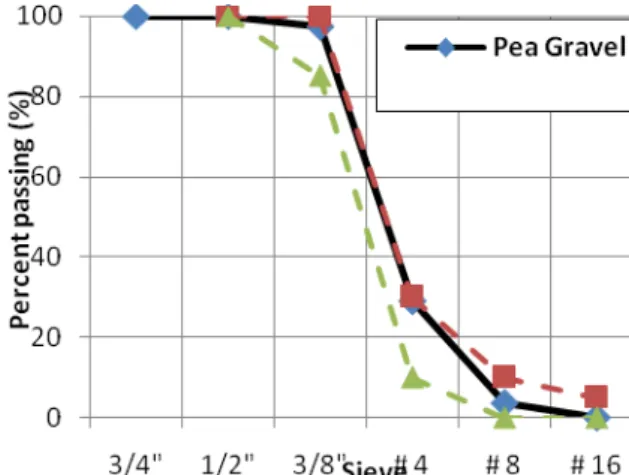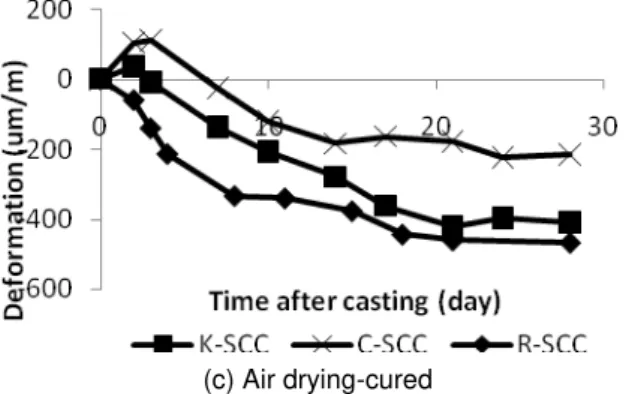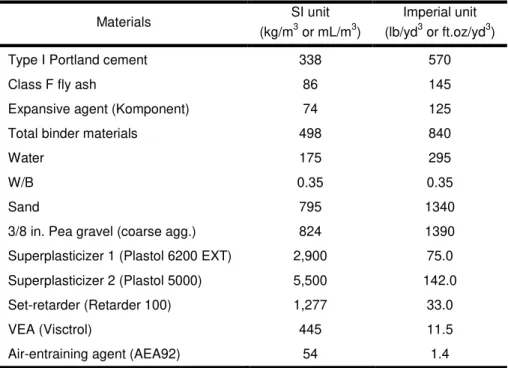First International Conference on Bio-based Building Materials June 22nd - 24th 2015
Clermont-Ferrand, France
EFFECT OF CURING CONDITION ON SHRINKAGE REDUCING PROPERTY OF
SELF-CONSOLIDATING CONCRETE WITH DIFFERENT EXPANSIVE
ADMIXTURES
Qi Cao1*, Kamal H. Khayat21 Dalian University of Technology, State Key Laboratory of Coastal and Offshore Engineering,
116024, Dalian, China
2 Missouri University of Science and Technology, Department of Civil, Architectural and
Environmental Engineering, 65409, Rolla, MO USA *Corresponding author; e-mail: qcao@dlut.edu.cn
Abstract:
In accelerated bridge construction, self-consolidating concrete (SCC) shows great potential of application to fill the gap between the deck soffit and precast concrete girders with heavy reinforcement especially in precast construction . An experimental program was undertaken to evaluate the performance of SCC incorporating different expansive admixtures for filling distance between precast bridge deck panels and girders. The study aimed to investigate shrinkage reducing properties as well as wokability of proposed SCC mixture under different curing conditions (water, air-dry and sealed cure). A combination of tests including slump flow, J-ring, V-funnel flow time, L-box and static bleeding were also conducted to measure the workability as well as mechanical properties of developed SCC.
Keywords:
self-consolidating concrete, shrinkage reducing, workability
1 INTRODUCTION
Currently, precast concrete deck systems are either partial depth or full-depth with open channels/pockets that require cast-in-place concrete and deck overlay. Their operations negatively affect the quality and speed of construction, which are the main goals of using precast deck systems. Precast full-depth bridge deck system for precast/prestressed concrete girder bridges has gain increasingly popularity due to its advantages such as improved construction quality, reduced construction time and impact on traveling public. To provide load transfer from one adjacent element to another, the pocket or called keyway need to be grouted with grouting materials. It is of great interest to study the constructability of the developed deck system to improve its competitiveness against cast-in-place concrete deck. The Kearney East Bypass in Kearney, NE is the first bridge project that uses the latest developments in full-depth precast concrete deck systems for precast/prestressed concrete girder bridges. These developments include using full-depth full-width deck panels with covered individual pockets at 1.2 m (4 ft) spacing eliminating the need for deck overlay or exposed cast-in place concrete. Therefore, self-consolidating concrete (SCC) is critical to the success of the new deck system to fill the deck pockets and the large gap between the deck soffit and
precast concrete girders without the need for expensive commercial grouts.
Magnesium ammonium phosphate mortar (MAP: Mg-NH4-PO4) is widely approved by many DOTs as
grouting material in the US and Canada. Non-shrink Grout is also another commonly used grouting material. Conventionally, different types of grouts have been used as cast in place materials for the precast bridge deck system. Mrinmay (1986) documented a serials of materials used after 1973 to avoid joint failure in closure pours. These materials include sand-epoxy mortars, latex modified concrete, cement-based grout, non-shrink cement grout, epoxy mortar grout, calcium aluminate cement mortar and concrete, methylmethacrylate polymer concrete and mortar, and polymer mortar. Epoxy or polymer modified grouts can have significant advantages, such as a high strength of 41.4 MPa (6 ksi) in 6 hours, better bond, reduced chloride permeability, improved freezing-and-thawing durability, and lower creep. However, they are often significantly more expensive and less compatible with surrounding concrete. In addition, if the resin is used in too large a volume, the heat of reaction may cause it to boil, and therefore develop less strength and loose bond. It is documented by Nottingham (1996) that the typical nature of portland cement grouts virtually assures some shrinkage cracks in grout joints. Prepackaged magnesium ammonium phosphate
(MAP) based grout often extended with pea gravel can meet requirements, like high quality, low shrinkage, impermeable, high bond, high early strength, user friendly and low temperature curing ability (Nottingham 1996; Issa et al. 2003). Gulyas and Champa (1997) examined inadequacies in the selection of a traditional non-shrink grout for use in shear key ways. The MAP grout outperformed the non-shrink grout in all areas tested, including direct vertical shear, direct tension, longitudinal shear, bond, shrinkage, etc. Menkulasi and Roberts-Wollmann (2005) investigated the horizontal shear resistance of the connection between full-depth precast concrete bridge deck panels and prestressed concrete girders. Two types of grout were evaluated: a latex modified grout and a MAP grout. For both types of grout, an angular pea gravel filler was added. The MAP grout developed slightly higher peak shear stresses than the latex modified grout. Cementitious grouts have been used more in precast construction than epoxy or polymer-modified grouts (Matsumoto et al. 2001). A primary disadvantage of cementitious grouts is the shrinkage and cracking that result from the use of hydraulic cement. Non-shrink grout compensates for the shrinkage by incorporating expansive agents into the mix. With non-shrink grout, the effects of shrinkage cracks or entrapped air on the transfer of forces and bond are minimized, though not eliminated. ASTM C 1107 (2011) establishes strength, consistency, and expansion criteria for prepackaged, hydraulic-cement, non-shrink grout. As discussed above, varieties of materials are available for the case in place materials. However, research effort is still much needed to develop performance criteria for assisting engineers to select various cast in place materials, especially for accelerated bridge construction. Performance-based specifications focus on properties such as consistency, workability, strength, durability, and aesthetics, rewarding quality, innovation, and technical knowledge, in addition to promoting better use of materials, and thus present an immense opportunity to optimize the design of materials. The industry is evolving specifications from prescriptive requirements to performance-based concepts.
Issa et al (2003) evaluated performances of four different grout materials (Set 45, set 45 hot weather (HW), Set Grout, and polymer concrete) in precast concrete deck systems for different full scale loading test and recommend using Set Grout as jointing material for transverse connections. Nottingham (1996) pointed out that the most commonly used joint gout material to meet the low shrinkage, impermeable, high bond, high early strength characteristics were prepackaged magnesium ammonium phosphate [Mg-NH4-PO4] based grout (Master Builders Set 45) often
extended with pea gravel. It is documented (Zhu and Ma, 2010) that grout without coarse aggregate extension is usually referred to as neat grout, while grout with coarse extension, typically ½ in. or 3/8 in, is extended grout. Zhu and Ma (2010) evaluated both overnight cure materials (including neat/extended grout for cement based Euro-speed MP and MAP based five-star patch, SET 45 and SET 45 HW) and 7-day cure materials and developed the performance criteria for selecting durable cast-in-place materials. Gulyas (1997) compared nonshrink grout with magnesium ammonium phosphate (MgNH4PO4) grout
and reported a minimum 250 percent increase in
by Gulyas (1997) that there is no minimum bond strength requirement in ASTM C 1107 specification. The FHWA defines a set of high performance structural concrete performance characteristics for long-term concrete durability and strength of highway structures. Standard laboratory tests, specimen preparation procedures, and grades of performance were suggested for each characteristic. Because standard test methods sometimes offer different options, Russell and Ozyildirim (2006) modified the FHWA definition and proposed performance characteristic grades for high-performance structural concrete. Nottingham (1996) reported a panel grout specifications by PN& D (Peratrovich, Nottingham and Drage, Inc.) for Set 45, as shown in Table 4. It is recommended that 50% by weight pea gravel extension may be used with product provided that when air-cured it produces the required compressive strength properties.
Based on literature review and contacts with material suppliers and users, the proposed test methods for SCC is listed in Table 1.
Considering the fact that the shear pocket will be covered on top and the haunch is between precast decks and girders, the grouting material would not be exposed in the studied application. It is worthwhile to point out that the durability performances of grouting material are not concerns in this study. Performance characteristics including workability (filling ability, passing capacity and stability), compressive strength, shrinkage are investigated as performance criteria. The objective of this study is to experimentally investigate the effectiveness of using SCC to fill the gap between the precast concrete girder and precast deck soffit as well as the shear pockets in the deck panel. It is important to investigate the constructability of the developed deck system to improve its competitiveness against cast-in-place concrete decks. This includes developing a specific SCC mixture(s) for this special application and evaluating its flowability and pumpability in small-scale and full-scale laboratory settings.
2 EXPERIMENTAL PROGRAM 2.1 Materials
For all the investigated mixtures, Type I Portland cement with specific gravity of 3.15 was used. Either Type F or Type C Fly ash was employed at 20% of total cementitious materials weight. It is important to reduce and compensate the shrinkage of concrete materials by adding expansive cement or expansive component. Two different expansive components were selected as the candidate materials through contacts with materials suppliers and users. They are Komponent cement (Type K) and Conex cement (Type G).
2.2 Methods
As presented in Table 1, the proposed test methods include mixture component characterization, fluidity, passing ability, stability, compressive strength and shrinkage and expansion of SCC. The slump flow test and a V-funnel test with 30mmx30mm opening were used to evaluate the filling ability of SCC and retention in 2-3 hours as well. and L-box and J-ring tests were used to evaluate the passing ability of SCC.
mixtures. In addition to static bleeding, column segregation and sieve stability tests were also used to evaluate stability of SCC.
Several 100mm x 200 mm cylinder specimens were cast to determine the compressive strength at 1, 7, 28 days of age. Concrete cylinders tested at 7 and 28 days were demolded at 1 day and then immersed in 100% lime water until test age. For the second group of characterization, drying shrinkage and expansion were tested according to ASTM C 157 using digital comparator. Concrete was poured into 76mm x 76mm x 254mm (3in. x3 in. x 10 in.) steel molds and cured for 1 day. After demolding, the prisms were underwent three different cure condition, including air-dying cured, water cured and sealed cure. For sealed cure condition, specimens were sealed with adhesive aluminum tape to prevent moisture loss then stored in room at 23 ±1℃. Shrinkage and expansion data were collected by sealing the specimen in plastic bags until test age. Figure 3 shows the specimen wrapped in aluminum foil before sealed in plastic bag. Figure 4 shows the test set up for measuring expansion and shrinkage of concrete prism specimens.
3 RESULTS AND DISCUSSION 3.1 Component characterization
Natural sand with specific gravity of 2.53 and absorption of 0.62% was used as fine aggregate. Pea gravel of MSA of 3/8 in. was used as coarse aggregate. Specific gravity and absorption values of the grave were 2.54 and 2.7%, respectively. It is important to note that the natural sand and Pea gravel used in this project meet sieve gradation limits elaborated in ASTM C 33, “Standard Specification for Concrete Aggregates”, as presented in Figures 1 and 2.
Figure 1 – Sieve analysis results of fine aggregate and ASTM limits
3.2 SCC mixture design
Mix designs are shown in Table 2 and Table 3 for SCC with Type K admixture and Type G admixture respectively.
Figure 2 – Sieve analysis results of coarse aggregate and ASTM limits
3.3 Effect of curing condition on shrinkage-expansion of SCC
An experimental work was undertaken to compare the effect of different expansive agent on the deformation and compressive strength of corresponding concrete. Three concrete mixtures were prepared with Komponent, Conex, and without any expansive agent. For each concrete, after demolding, prism samples were subjected to different exposure conditions, which include air-drying at controlled temperature of 23 ± 2ºC and relative humidity of 50 ± 4%, sealed and stored at 23 ± 2ºC, and immersed in the lime-saturated water at 23 ± 2ºC. Similarly, cylindrical samples were exposed to water-curing (lime-saturated) and sealed-curing in a plastic bag.
Fresh properties of the three mixtures are presented in Table 4. All the three mixtures met the targeted performance range set for this project, which include high flowability, high passing ability, as well as static stability. Among the three mixtures, SCC made with Komponent expansive agent exhibited slightly greater slump flow and higher passing ability compared to the other two mixtures, as presented in Table 4. In the case of compressive strength, there is no clear difference, regardless of the expansive agent and curing condition.
Effect of different expansive agents on deformation of the concrete is compared in Figures 5 to 7. It is interesting to note that the influence of expansive agents on the deformation differs with curing condition. For example, in the case of water-curing, concrete containing Komponent had almost 200% higher expansion than similar mixture with Conex. On the other hand, air-dried samples of Komponent mixture had 200% higher shrinkage at 28 days compared to those made with Conex (-410 vs. -213 microstarins). Similarly, under the sealed condition, concrete made with Conex had relatively higher expansion than similar concrete containing Komponent. It should be noted that actually, Komponent expansive agent did not deliver considerable shrinkage reduction over that of control mixture (non-expansive) under air-drying condition, as presented in Figure 7. Therefore, it can be concluded that Type G expansive cemetn (Conex) shows the best potential of expansion of all expansive admixtures.
Figure 3 – Sealed concrete specimen
Figure 4 – Shrinkage test setup
Figure 5 Deformation of concrete mixtures made with different expansive admixtures at water-cured
condition
Figure 6 – Deformation of concrete mixtures made with different expansive admixtures at sealed-cured
condition
(c) Air drying-cured
Figure 7 – Deformation of concrete mixtures made with different expansive admixtures at air dying-cured
condition
4 CONCLUSIONS
Based on the results obtained in this study, the following conclusions appear to be warranted:
1. A combination of the slump flow, V-funnel and either L-box (h2/h1), J-ring, can be used to assess filling
ability and passing capacity of SCC for quality control and design of SCC for placement in restricted sections. 2. The optimized SCC mixture exhibits excellent fluidity, passing ability, resistance to static bleeding and adequate compressive strength and expansion. 3. Type K and Type G expansive agents were used and compared for shrinkage and expansion capacity. SCC made with Type G expansive agent had higher expansion than similar concrete prepared with Type K agent under sealed condition which is similar to the field service condition for the deck and girder connection.
5 ACKNOWLEDGMENTS
The authors wish to thank Euclid and CTS for providing expansive agent and chemical admixtures. The financial support provided by UTC (University Transportation Center), National Natural Science Foundation of China (NSFC) (Project No. 51208077) and The Scientific Research Foundation for the Returned Overseas Chinese Scholars, State Education Ministry (SRF for ROCS, SEM #47) are gratefully acknowledged. The assistance of Soo-Duck Hwang and Jason Cox are especially acknowledged.
6 REFERENCES
ASTM C1107, Standard Specification for Packaged Dry, Hydraulic-Cement Grout (nonshrink), ASTM, West Conshohocken, PA, 2011.
Gulyas, R. J. and Champa, J. T., Use of Composite Testing for Evaluation of Keyway Grout for Precast Prestresse Bridge Beams, American Concrete Institute (ACI) Materials Journal, 1997, V. 94, pp. 244-250. Issa, M. A. D., Ribeiro Do Valle C.L., Abdalla, H. A., Islam, S. and; Issa, M. A., Performance of transverse joint grout materials in full-depth precast concrete bridge deck systems, PCI Journal, 2003, V.48, p.45-48.
Matsumoto, E., Waggoner, M. C., Sumen G., Kreger, M. E., and Breen, J. E., Development of a Precast Bent Cap System, University of Texas Austin, Project summary report 1748-S, March, 2001
Menkulasi, F. and Roberts-Wollmann, C. L., Behavior of Horizontal Shear Connections for Full-Depth Precast Concrete Bridge Decks on Prestressed I-Girders, Precast/Prestressed Concrete Institute (PCI) Journal, 2005, V. 50, No. 3, May-June, pp. 60-73.
Mrinmay B., Precast Bridge Deck Design System, Prestressed/Precast Concrete Institute (PCI) Journal, 1986, V. 31, No. 2, March-April, pp. 40-86.
Nottingham, D., Joints Grouting in Alaskan Bridges and Dock Decks, Concrete International, 1996, V. 18, No. 2, February, pp.45-48.
Russell, H. G. and Ozyildirim, H. C., Revising high performance concrete classifications, Concrete International, 2006, August, pp.43-49.
Zhu, P. and Ma, Z. J., Selection of durable closure pour materials for accelerated bridge construction, Journal of Bridge Engineering, ASCE, 2010, V. 15, No. 6, pp. 695-704.
Table 1 Proposed test methods for self-consolidating concrete
Performance Characteristic Test method for concrete Sieve analysis for aggregates ASTM C 136
Density and absorption ASTM C 127
Air content ASTM C 231
Temperature ASTM C 1064
Flowability Slump flow (T50, VSI) (ASTM C1611) up to 3 hours retention Passing ability V-funnel test, L-box and J-ring
Stability Static bleeding (ASTM C 940), Static column segregation (ASTM C1610) and sieve stability Compressive strength Compressive strength (ASTM C39)
Shrinkage & Expansion ASTM 157 (drying)
Table 2 – Mixture composition of SCC with Type K expansive admixture (Komponent)
Materials SI unit
(kg/m3 or mL/m3)
Imperial unit (lb/yd3 or ft.oz/yd3)
Type I Portland cement 338 570
Class F fly ash 86 145
Expansive agent (Komponent) 74 125
Total binder materials 498 840
Water 175 295
W/B 0.35 0.35
Sand 795 1340
3/8 in. Pea gravel (coarse agg.) 824 1390 Superplasticizer 1 (Plastol 6200 EXT) 2,900 75.0 Superplasticizer 2 (Plastol 5000) 5,500 142.0
Set-retarder (Retarder 100) 1,277 33.0
VEA (Visctrol) 445 11.5
Table 3 – Mixture composition of SCC with Type G expansive admixture (Conex)
Materials SCC with Conex
SI unit (kg/m3 or mL/m3)
Imperial unit (lb/yd3 or ft.oz/yd3)
Type I Portland cement 356 600
Class F fly ash (20% of total binder) 106 179
Expansive agent (Conex) 52 87
Total binder materials 514 866
Water, initial 173 292
w/b 0.34 0.34
Sand 958 1615
3/8 in. Pea gravel (coarse agg.) 638 1077 Superplasticizer 1 (Plastol 6200 EXT) 2900 75.0 (initial) Superplasticizer 2 (Plastol 5000) 262 6.8
Set-retarder (Retarder 100) 1277 33.0
VEA (Visctrol) 1312 33.9
Air-entraining agent (AEA92) 54 1.4
Table 4 – Fresh properties and compressive strength of SCC made with different expansive agent
Testing age (minute)
Komponent Conex Non-expansive (Control)
Properties 10 70 15 75 15 75 slump flow(mm) 800 780 762 718 755 737 V-funnel (sec) 5.1 5.5 3.3 4.0 4.2 4.6 Air content (%) 5.2 6.5 5.5 3.5 5.0 5.5 L-box ratio (h2/h1) 1.0 1.0 0.89 0.86 0.93 0.86 J-ring (mm) 775 662 743 705 700 685 Static bleeding 0 - 0 - 0 -
Compressive strength (psi)
Age Komponent Conex Non-expansive (Control)
water sealed water sealed water sealed
1 day 2825 2420 2445 2430 1905 2130
7 days 4600 4500 4785 4905 4290 4410



